Unit 6 Nature in words Understanding ideas课件--2024-2025学年高中《英语》选择性必修3(外研版)
文档属性
| 名称 | Unit 6 Nature in words Understanding ideas课件--2024-2025学年高中《英语》选择性必修3(外研版) | 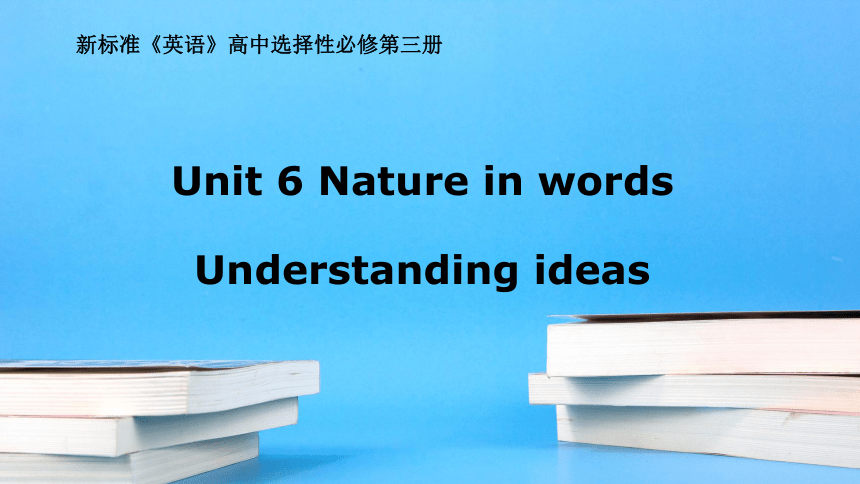 | |
| 格式 | pptx | ||
| 文件大小 | 2.1MB | ||
| 资源类型 | 教案 | ||
| 版本资源 | 外研版(2019) | ||
| 科目 | 英语 | ||
| 更新时间 | 2025-07-08 22:14:26 | ||
图片预览

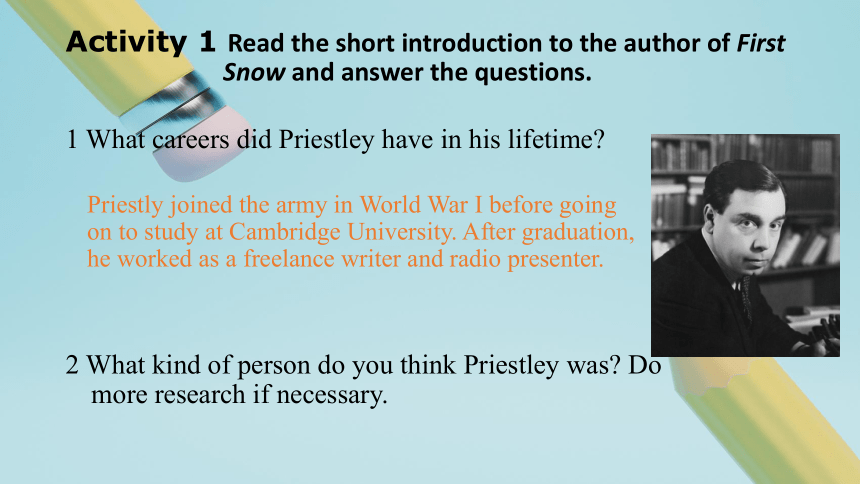
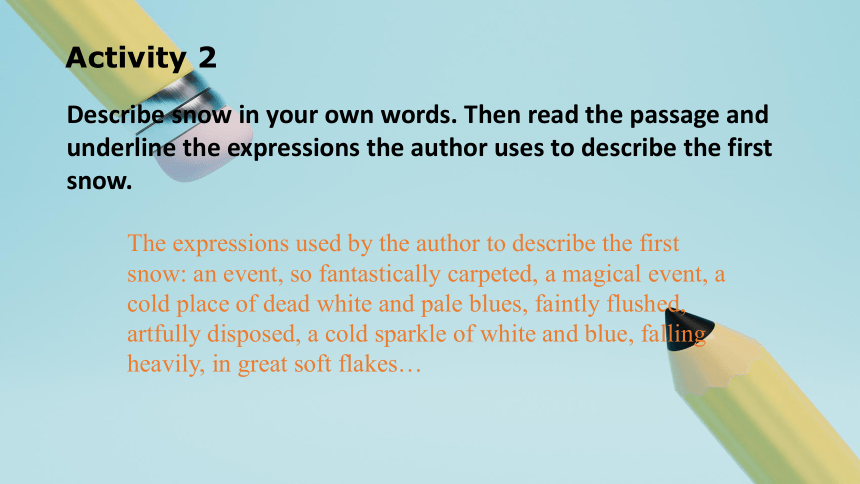
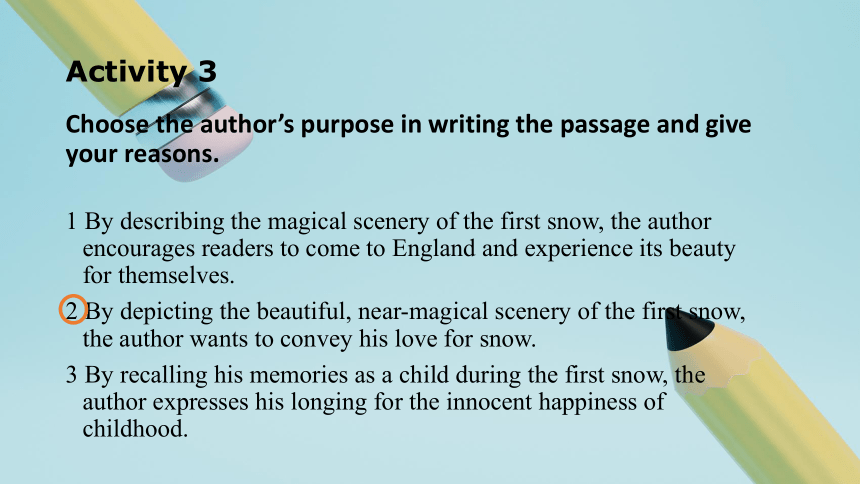
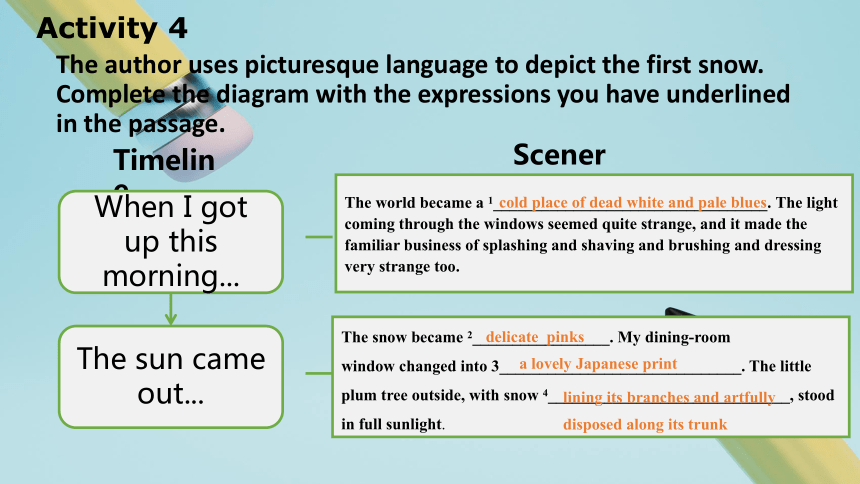
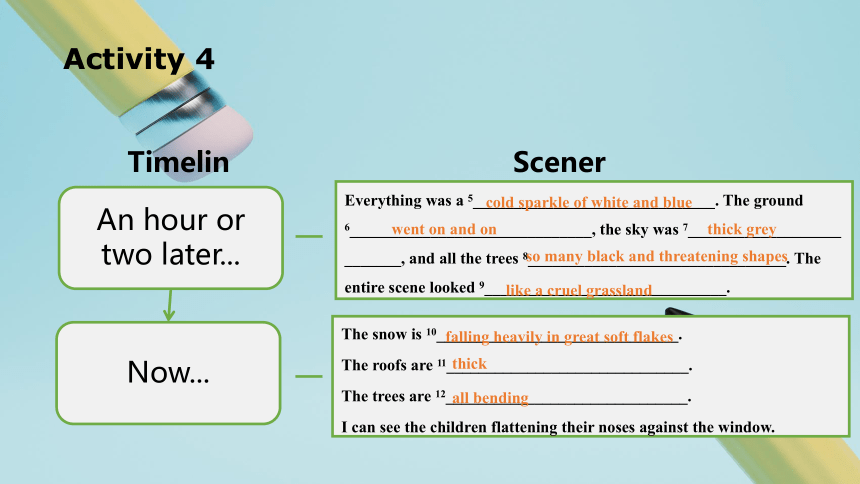
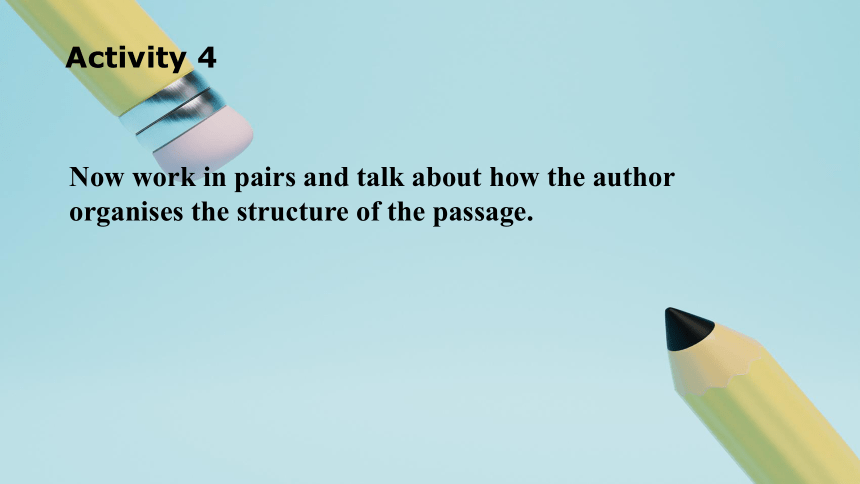
文档简介
(共15张PPT)
Unit 6 Nature in words
新标准《英语》高中选择性必修第三册
Understanding ideas
Activity 1 Read the short introduction to the author of First Snow and answer the questions.
1 What careers did Priestley have in his lifetime
Priestly joined the army in World War I before going on to study at Cambridge University. After graduation, he worked as a freelance writer and radio presenter.
2 What kind of person do you think Priestley was Do more research if necessary.
Activity 2
The expressions used by the author to describe the first snow: an event, so fantastically carpeted, a magical event, a cold place of dead white and pale blues, faintly flushed, artfully disposed, a cold sparkle of white and blue, falling heavily, in great soft flakes…
Describe snow in your own words. Then read the passage and underline the expressions the author uses to describe the first snow.
Activity 3
1 By describing the magical scenery of the first snow, the author encourages readers to come to England and experience its beauty for themselves.
2 By depicting the beautiful, near-magical scenery of the first snow, the author wants to convey his love for snow.
3 By recalling his memories as a child during the first snow, the author expresses his longing for the innocent happiness of childhood.
Choose the author’s purpose in writing the passage and give your reasons.
Activity 4
Timeline
Scenery
When I got up this
morning...
The sun came out...
The world became a 1__________________________________. The light
coming through the windows seemed quite strange, and it made the
familiar business of splashing and shaving and brushing and dressing very strange too.
The snow became 2_________________. My dining-room
window changed into 3______________________________. The little plum tree outside, with snow 4______________________________, stood in full sunlight.
cold place of dead white and pale blues
delicate pinks
a lovely Japanese print
lining its branches and artfully
disposed along its trunk
The author uses picturesque language to depict the first plete the diagram with the expressions you have underlined in the passage.
Activity 4
Timeline
Scenery
An hour or two later...
Now...
Everything was a 5______________________________. The ground 6______________________________, the sky was 7___________________
_______, and all the trees 8________________________________. The entire scene looked 9______________________________.
The snow is 10______________________________.
The roofs are 11______________________________.
The trees are 12______________________________.
I can see the children flattening their noses against the window.
cold sparkle of white and blue
went on and on
thick grey
all bending
so many black and threatening shapes
like a cruel grassland
falling heavily in great soft flakes
thick
Activity 4
Now work in pairs and talk about how the author organises the structure of the passage.
Think & Share
1 Why does the author mention Jane Austen at the beginning of the passage
By referencing the characters of Jane Austen, who is known for her witty, perceptive observations of early 19th century English country life, the author is emphasising the irony and self-awareness with which he goes on to make his statement about the first snow.
Think & Share
2 What images does the author use to enhance the description of snow
Images used by the author to enhance the description of snow: a cold place of dead white and pale blues, flushing the snow with delicate pinks, a cold sparkle of white and blue, falling heavily, in great soft flakes…
Think & Share
3 What other literary works about snow do you know Share them with the class.
4 Have you encountered any difficulties in understanding this passage Can you use visualisation to better understand the passage
Unit 6 Nature in words
新标准《英语》高中选择性必修第三册
Starting out
Activity 1 Watch the video and answer the questions.
2 What other nature writers do you know of Tell the class about him or her.
Poems, letters, travel journals, essays and novels are the literary forms mentioned in the video.
1 What literary forms are mentioned in the video
Activity 2 Listen and read the poem by Emily Dickinson. Answer the questions.
1 What images are used to symbolise nature
Nature is symbolised by simple images of animals (“Squirrel”, “the Bumble bee”, “The Bobolink”, “the Cricket”) and features (“The Hill”, “the Afternoon”, “Eclipse”, “the Sea”, “Thunder”), which are in turn symbolic of the poet’s thoughts and feelings about the simplicity of nature. Nature is also symbolised in a metaphorical sense when it is described as “Heaven” and “Harmony”.
Activity 2
2 What message does the poem try to convey
3 What does nature mean to you
The message of the poem is that although what we see and hear in nature appears to be simple, within that simplicity lie great beauty, mystery and magnificence that humans cannot truly appreciate or capture in their art.
THANK YOU
Unit 6 Nature in words
新标准《英语》高中选择性必修第三册
Understanding ideas
Activity 1 Read the short introduction to the author of First Snow and answer the questions.
1 What careers did Priestley have in his lifetime
Priestly joined the army in World War I before going on to study at Cambridge University. After graduation, he worked as a freelance writer and radio presenter.
2 What kind of person do you think Priestley was Do more research if necessary.
Activity 2
The expressions used by the author to describe the first snow: an event, so fantastically carpeted, a magical event, a cold place of dead white and pale blues, faintly flushed, artfully disposed, a cold sparkle of white and blue, falling heavily, in great soft flakes…
Describe snow in your own words. Then read the passage and underline the expressions the author uses to describe the first snow.
Activity 3
1 By describing the magical scenery of the first snow, the author encourages readers to come to England and experience its beauty for themselves.
2 By depicting the beautiful, near-magical scenery of the first snow, the author wants to convey his love for snow.
3 By recalling his memories as a child during the first snow, the author expresses his longing for the innocent happiness of childhood.
Choose the author’s purpose in writing the passage and give your reasons.
Activity 4
Timeline
Scenery
When I got up this
morning...
The sun came out...
The world became a 1__________________________________. The light
coming through the windows seemed quite strange, and it made the
familiar business of splashing and shaving and brushing and dressing very strange too.
The snow became 2_________________. My dining-room
window changed into 3______________________________. The little plum tree outside, with snow 4______________________________, stood in full sunlight.
cold place of dead white and pale blues
delicate pinks
a lovely Japanese print
lining its branches and artfully
disposed along its trunk
The author uses picturesque language to depict the first plete the diagram with the expressions you have underlined in the passage.
Activity 4
Timeline
Scenery
An hour or two later...
Now...
Everything was a 5______________________________. The ground 6______________________________, the sky was 7___________________
_______, and all the trees 8________________________________. The entire scene looked 9______________________________.
The snow is 10______________________________.
The roofs are 11______________________________.
The trees are 12______________________________.
I can see the children flattening their noses against the window.
cold sparkle of white and blue
went on and on
thick grey
all bending
so many black and threatening shapes
like a cruel grassland
falling heavily in great soft flakes
thick
Activity 4
Now work in pairs and talk about how the author organises the structure of the passage.
Think & Share
1 Why does the author mention Jane Austen at the beginning of the passage
By referencing the characters of Jane Austen, who is known for her witty, perceptive observations of early 19th century English country life, the author is emphasising the irony and self-awareness with which he goes on to make his statement about the first snow.
Think & Share
2 What images does the author use to enhance the description of snow
Images used by the author to enhance the description of snow: a cold place of dead white and pale blues, flushing the snow with delicate pinks, a cold sparkle of white and blue, falling heavily, in great soft flakes…
Think & Share
3 What other literary works about snow do you know Share them with the class.
4 Have you encountered any difficulties in understanding this passage Can you use visualisation to better understand the passage
Unit 6 Nature in words
新标准《英语》高中选择性必修第三册
Starting out
Activity 1 Watch the video and answer the questions.
2 What other nature writers do you know of Tell the class about him or her.
Poems, letters, travel journals, essays and novels are the literary forms mentioned in the video.
1 What literary forms are mentioned in the video
Activity 2 Listen and read the poem by Emily Dickinson. Answer the questions.
1 What images are used to symbolise nature
Nature is symbolised by simple images of animals (“Squirrel”, “the Bumble bee”, “The Bobolink”, “the Cricket”) and features (“The Hill”, “the Afternoon”, “Eclipse”, “the Sea”, “Thunder”), which are in turn symbolic of the poet’s thoughts and feelings about the simplicity of nature. Nature is also symbolised in a metaphorical sense when it is described as “Heaven” and “Harmony”.
Activity 2
2 What message does the poem try to convey
3 What does nature mean to you
The message of the poem is that although what we see and hear in nature appears to be simple, within that simplicity lie great beauty, mystery and magnificence that humans cannot truly appreciate or capture in their art.
THANK YOU
